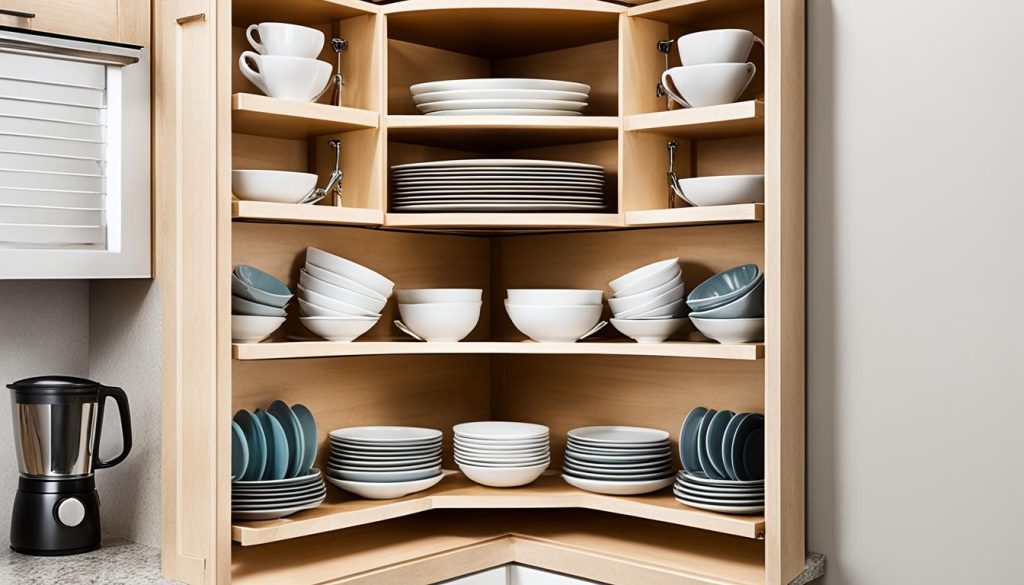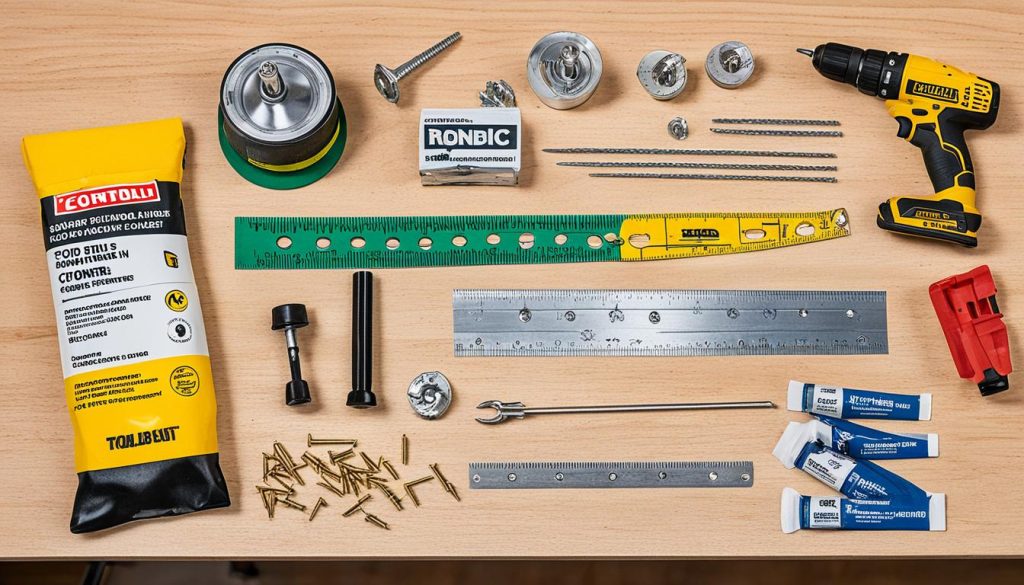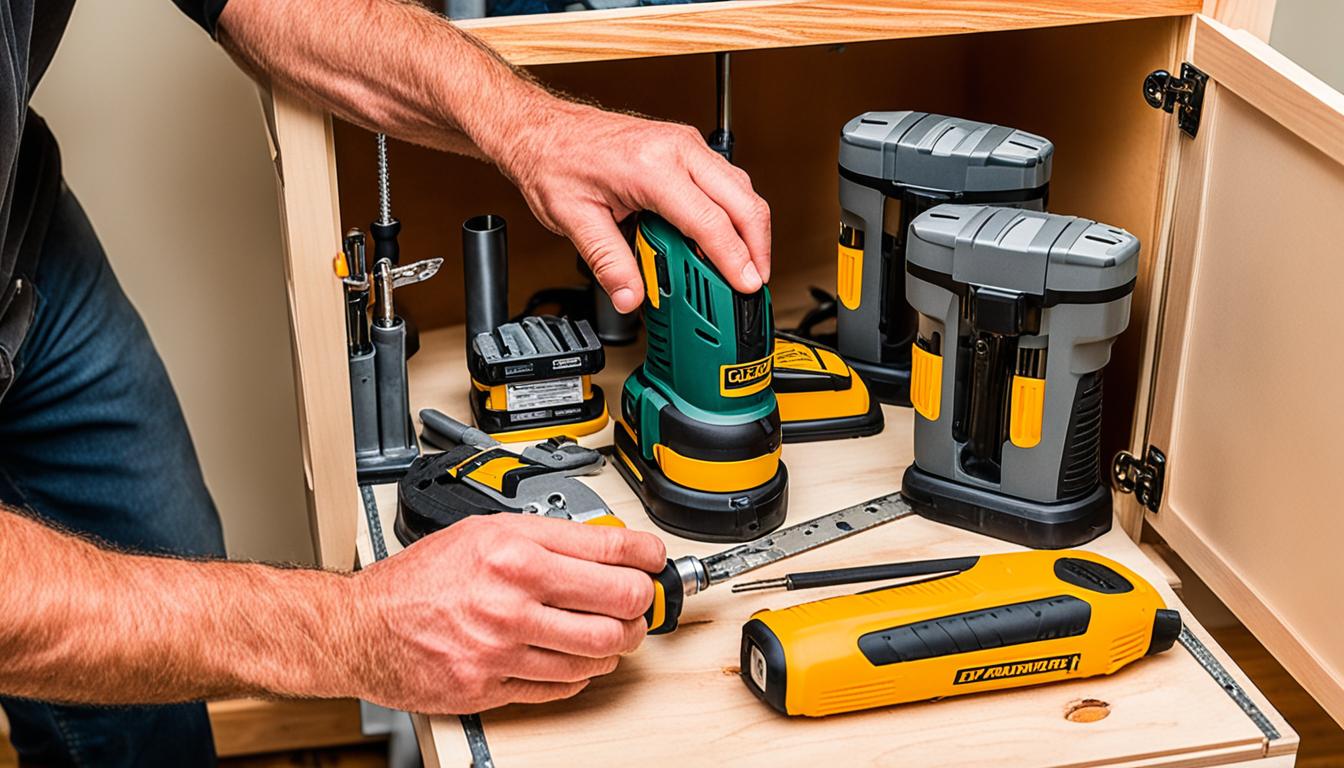I’m thrilled to share my knowledge on installing lazy susans in corner cabinets. These are a big help for kitchen storage. I’ve worked on many DIY cabinet projects. This guide will show you how to make the most of your kitchen space.
Corner cabinets can be tough to use in the kitchen. But, with a lazy susan installation, you can turn them into great storage spots. Let’s explore how rotating shelves and smart storage can change your kitchen.
First, let’s talk about what makes up a lazy susan. It has two plates with ball bearings in between. The top plate has holes at each corner. The bottom plate has a big and a small hole at each corner.
To install it, you’ll need certain tools. You’ll need a compass, pencil, ruler, 1/8″ drill bit, countersink drill bit, and a power drill. Also, get eight #8 screws that match your cabinet’s thickness.
Key Takeaways
- Lazy susans maximize corner cabinet storage
- Installation requires specific tools and hardware
- The process involves precise measurements and drilling
- Lazy susans improve kitchen organization and accessibility
- Professional guidance can ensure a smooth installation
Understanding Lazy Susan Corner Cabinets

Lazy Susan cabinets are a big deal in kitchen storage. They turn cluttered corners into neat spots. Let’s look at how these rotating systems work and their benefits.
What is a Lazy Susan cabinet?
A Lazy Susan cabinet is a special corner unit with shelves that turn around. It usually has two trays that spin 360 degrees. This makes it great for tight kitchen spots. The lazy susan definition is all about making things easy to get to in hard spots.
Benefits of installing a Lazy Susan
There are many good things about putting in a Lazy Susan:
- It uses corner space well
- Makes things easier to get to
- Helps keep cabinets tidy
- Makes the kitchen look better organized
Types of Lazy Susan corner cabinets
There are different Lazy Susan designs for every kitchen:
| Type | Description | Best For |
|---|---|---|
| Round | Full-circle rotating trays | Large corner spaces |
| Semi-circle | Half-moon shaped trays | Smaller corners |
| Triangular | Cut trays fitting snugly in corners | Tight spaces |
When picking a Lazy Susan, measure your corner cabinet well. This makes sure it fits right and works great in your kitchen.
Preparing for Installation

I’m getting ready for cabinet installation and it’s key to have all tools before starting. A detailed pre-installation checklist helps avoid delays and problems later. Let’s look at the main tools needed for a smooth lazy Susan corner cabinet installation.
First, I’ll collect my tools. You’ll need a level, measuring tape, drill, screws, and shims. Did you know that lazy Susan installations are about 50% faster than traditional shelves? This makes them a top choice, with 1 in 3 modern kitchens having one.
Then, I’ll check the corner space. Irregular corners and walls can mess up the installation, so I’ll measure carefully. Lazy Susan corner cabinets are 25% more stable than traditional ones, which is a big plus.
Next, I’ll clean the area. I’ll make sure the cabinets next to it are set up right, which is important for a good fit. Putting together a lazy Susan corner cabinet usually takes about 2 hours, so I’ll plan my time well.
| Item | Quantity | Notes |
|---|---|---|
| Level | 1 | Essential for proper alignment |
| Measuring Tape | 1 | For precise measurements |
| Drill | 1 | Power tool for efficient installation |
| Screws | 8 | Phillips Black Bugle-Head Drywall Screws |
| Shims | As needed | For leveling and adjusting |
With everything prepared, I’m set to start the installation. A good pre-installation checklist is crucial for a successful lazy Susan corner cabinet setup.
Measuring and Assessing the Corner Space
Getting the corner measurement right is key for a great Lazy Susan cabinet setup. I’ll show you how to check your corner space, handle common problems, and make sure it fits perfectly.
Dealing with Out-of-Square Corners
Many kitchens have corners that aren’t quite right. I use a special tool to figure out the corner angle. If it’s off by a bit, I adjust the cabinet’s depth by 1/2″ to 1″ to fit.
Adjusting for Wall Irregularities
Walls can have bumps or curves that affect cabinet installation. I look closely at the walls for any uneven spots. For small issues, shims can level things out. For bigger problems, I use CAD software to find the right clips for the back corner.
Accounting for Adjacent Cabinets
The size and position of nearby cabinets matter for your Lazy Susan. I measure the space, aiming for a 24-inch corner base cabinet for the best storage. This makes sure it fits well with your other cabinets.
| Corner Type | Recommended Cabinet | Storage Capacity |
|---|---|---|
| 90-degree corner | Kidney-shaped Lazy Susan | 25-50 lbs per shelf |
| Irregular corner | D-shaped Lazy Susan | 20-45 lbs per shelf |
| Tight corner | Pie-cut Lazy Susan | 15-40 lbs per shelf |
By looking closely at your corner space and fixing any issues, you’ll make installing your Lazy Susan cabinet smooth. This careful planning leads to a useful and good-looking addition to your kitchen.
Choosing the Right Lazy Susan Cabinet
Finding the right lazy susan cabinet is key for your kitchen’s look. Corner cabinet sizes are very important in this choice. Make sure to measure your space well and pick a cabinet that fits perfectly.
Base cabinets usually have a depth of 24 inches. But, being flexible is crucial. I suggest choosing a cabinet that can adjust its depth or one that’s easy to change. This is very helpful in older homes with uneven walls.
Size is crucial when picking a lazy susan cabinet. The lazy susan should be 2 to 4 inches smaller than your cabinet’s shortest inside measurement. This ensures it rotates smoothly without hitting the walls. For instance, if your cabinet is 30 inches wide, look for a lazy susan between 26 to 28 inches in diameter.
I always go for frameless cabinets with solid backs. They’re simpler to adjust during installation, which is great for tricky corners. They also have a sleek, modern look that fits many kitchen styles.
| Cabinet Type | Lazy Susan Shape | Best For |
|---|---|---|
| Corner with double folding doors | Kidney shape | Maximizing corner space |
| Corner with attached door | Pie cut | Strong 90-degree angle |
| Diagonal 45-degree corner | D-shaped | Wall and base cabinets |
| Regular corner or standard cabinet | Full circle | Versatile use |
Most lazy susans have telescoping shafts, fitting cabinet heights from 26 to 31 inches. This makes them good for kitchens of all sizes, from small to large.
How Do You Install a Lazy Susan Corner Cabinet
Installing a Lazy Susan corner cabinet can change your kitchen storage for the better. I’ll show you the steps, tools, and tips for a smooth installation.
Step-by-Step Installation Process
Begin by placing the cabinet in the corner. Make sure it’s straight using a level. Then, attach it to nearby cabinets and walls with 3-inch #10 screws. Use toggle bolts for drywall and #10 wall anchors for concrete walls.
Drill 3/16-inch pilot holes through the back panel into wall studs. This secures the cabinet well.
Tools and Materials Needed
Here are the tools you’ll need:
- Drill
- Level
- Shims
- Screws (3-inch #10 and 2.5-inch #8)
- C-clamps
- Measuring tape
Tips for a Smooth Installation
Here are some tips for a successful installation:1. Get help for safety and precision.2. Use c-clamps to keep cabinets together.3. Adjust with shims for the right angles.4. Drill pilot holes before screwing cabinets together.5. For non-square corners, adjust the cabinet’s depth or use clips.6. Consider a two-piece installation for tricky corners.
| Cabinet Type | Hinge Type | Number of Doors |
|---|---|---|
| Lazy Susan Corner | 170-degree hinges | 2 |
| Lazy Susan Corner | Pie Cut Corner Hinges | 2 |
Lazy Susan cabinets come in different styles like D-Shaped and Full-Round. They’re great for kitchens, bathrooms, and offices. With these tips, you’ll easily install a Lazy Susan cabinet and get more storage in your corner.
Adapting the Cabinet for Non-Square Corners
Non-square corners can be tough when putting in Lazy Susan cabinets. Custom corner solutions are essential for a perfect fit. Let’s look at some ways to adapt cabinets for these spaces.
Undersizing the Cabinet Depth
Undersizing the cabinet depth is a clever trick. For base cabinets, make the ends 23 3/4″ deep instead of 24″. This small change makes fitting into non-square corners easier without losing function.
Clipping the Back Corner
Trimming the back corner is another effective method. Cut about 1″ off the rear corner to fit into irregular spaces. Make sure the Lazy Susan hardware still fits after this adjustment.
Two-Piece Installation Method
For really out-of-square corners, I choose a two-piece setup. This means installing the cabinet sides separately for better adjustments. It’s a bit harder but gives more flexibility in tough spots.
| Adaptation Method | Best For | Difficulty Level |
|---|---|---|
| Undersizing Depth | Slightly Non-Square Corners | Easy |
| Clipping Back Corner | Moderate Irregularities | Moderate |
| Two-Piece Installation | Severely Out-of-Square Corners | Advanced |
These custom corner solutions have solved many non-square corner problems. The main idea is to adapt the cabinet without losing its look or function.
Aligning and Securing the Cabinet
Getting your Lazy Susan corner cabinet right is key. I’ll show you how to make sure it’s level, plumb, and secure.
Leveling and Aligning
First, put the cabinet in its spot. Use shims to level it, checking with a spirit level on top and front. Make sure it’s 54″ above the floor. Also, make sure it’s straight on all sides.
Securing to Adjacent Cabinets
After leveling, attach the Lazy Susan to nearby cabinets. Clamp them together to make sure they’re even, then drill pilot holes. Use cabinet screws to secure them, but don’t overtighten. For upper cabinets, check that mounting holes are at least ½” from the edge.
Wall Attachment
Find the wall studs and mark them. Drill holes through the cabinet and into studs. Use 2″ wood screws to attach it to the wall. If studs aren’t there, use toggle bolts for extra hold.
| Component | Recommended Fastener | Spacing |
|---|---|---|
| Cabinet to Wall | 2″ Wood Screws | Every 16″ on studs |
| Cabinet to Cabinet | Cabinet Screws | Top, middle, bottom |
| Support Strip | Toggle Bolts | Every 12″ if no stud |
Remember, getting it right with alignment and securing is crucial for a working Lazy Susan corner cabinet. Take your time with these steps for a stable, lasting setup.
Finishing Touches and Troubleshooting
I’ve worked on many lazy susan corner cabinets. The final steps are key to a successful project. Let’s look at the finishing touches and troubleshooting tips to help you succeed.
Installing the Lazy Susan Mechanism
The lazy susan mechanism is the core of your corner cabinet. Always follow the manufacturer’s instructions closely. I’ve found custom-built lazy susans with ball bearings and steel rods work best. A cabinetmaker told me it took nine hours to adjust doors right, showing how important precision is.
Adjusting Doors and Hardware
Adjusting cabinet doors is vital for everything to work right. No-mortise hinges are great for revolving-door lazy susans. For pie-cut types, adjust the doors so shelves don’t hit the face frame. Here are some common issues and how to fix them:
| Issue | Solution | Time Required |
|---|---|---|
| Door scraping | Fine-tune hinge placement | 1-2 hours |
| Misaligned shelves | Adjust shelf brackets | 30 minutes – 1 hour |
| Binding rotation | Lubricate mechanism | 15-30 minutes |
Common Issues and Solutions
In my 21 years of experience, I’ve seen many challenges with lazy susan cabinets. Here are some tips to fix common problems:
- Limited visibility: Choose pie-cut shelves over circular ones
- Narrow door opening: Pick a different cabinet style if the opening is less than 10″
- Cleaning difficulties: Add removable shelves for easy cleaning
- Wasted space: Consider corner drawers or a blind corner system
If you’re still having trouble, don’t hesitate to get professional help. Proper installation and adjustment of your lazy susan mechanism can prevent future problems and save you time.
Conclusion
I’ve shown you how to install a lazy susan for a better kitchen. This guide helps turn a tricky corner into a spot for easy storage. Make sure to measure carefully – it’s very important.
A lazy susan gives you 360-degree access to your items, making every inch count. You can pick a size that matches your space. For example, a full-round one can hold up to 8 pans, while a half-round is great for smaller spots.
Interior designer Sarah Johnson says, “A well-installed lazy susan can boost your kitchen’s storage by up to 50%.” With good planning and care, you’ll soon have a tidy kitchen. The secret to success is patience, precision, and creativity.
FAQ
What is a lazy susan cabinet?
A lazy susan cabinet is a special kind of storage for corners in kitchens. It has a round or kidney-shaped shelf that turns. This makes it easy to get to items at the back.
What are the benefits of installing a lazy susan corner cabinet?
These cabinets make the most of tricky corner spots and use space well. They let you easily reach items at the back by turning the shelf.
What tools and materials are needed for a lazy susan cabinet installation?
You’ll need tools like a level, measuring tape, drill, screws, and shims. You might also use CAD software for tricky corners. The cabinet and any needed hardware or mechanisms are also required.
How do you deal with out-of-square corners during installation?
For corners that aren’t square, you might make the cabinet a bit shallower. Or, use CAD to make a special corner clip. A two-piece setup can also work for big problems.
How do you choose the right lazy susan cabinet?
Think about the size of your corner, how deep you want the cabinet to be (usually 24″ for base ones), and your kitchen’s style. Look for cabinets that can be adjusted or have no frame for easier setup.
What are some tips for a smooth lazy susan cabinet installation?
Measure your corner well, think about any odd shapes or nearby cabinets, and follow the setup steps carefully. Making the cabinet a bit shallower, clipping corners, and using shims for leveling can help fit it right.
How do you install the lazy susan mechanism?
Just follow the maker’s guide to put in the lazy susan mechanism. It’s important for the cabinet to turn smoothly.
How do you troubleshoot common issues with lazy susan cabinets?
Issues like stuck doors, shelves that aren’t straight, or a lazy susan that doesn’t turn right can happen. Fixing these might mean adjusting the cabinet’s spot, tweaking the corner clip, or fine-tuning the mechanism.
